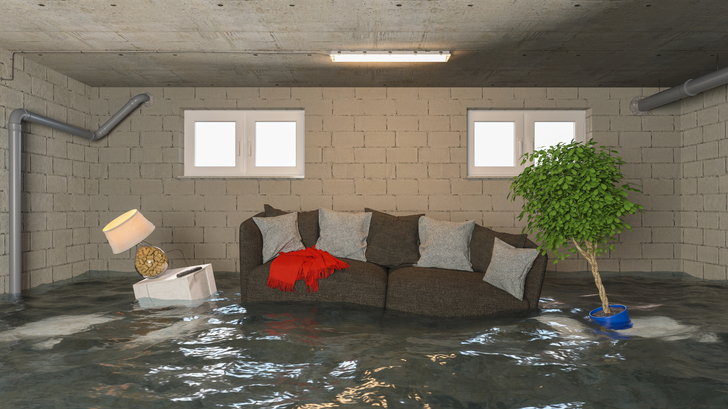Water damage is one of the biggest issues you’ll have to combat as a homeowner. It’s an issue you have to protect your home against during all months of the year. Excessive rainfall, especially during the summer, as well as snowfall during winter can cause problems for your home if the right precautions aren’t put into place. That’s why we’ve put together a guide to waterproofing your basement, so you can defend your home from this common residential issue through all months of the year.
Proper protection requires quite a bit of work and dedication, but once you put your waterproofing system into place, your home will have a better ability to defend itself against the elements.
Dig Up the Soil Around Your House
The first step to waterproofing your basement is digging up the soil surrounding the exterior of your foundation. Before doing this, make sure you obtain the right permits and adhere to the right local guidelines. This’ll require a bit of homework, but once you get all the legality issues sorted out, you can go ahead and excavate the soil around your foundation. After this, you can begin the inspection and sealing procedures.
Inspect for Any Cracks
After digging up the soil around your foundation, inspect it for any cracks. No matter what size the crack is, either massive or minuscule, you always need to cover it up. You can accomplish this with the help of several useful methods such as hydraulic cement, which will fill in cracks to help prevent water from seeping in.
There are other forms of mortar or concrete-based materials you can use to seal cracks shut, all of which can get the job done if you apply them effectively. Once you’ve inspected and patched up any and all holes in the foundation, you can apply another layer of waterproofing material: sealant.
Exterior Sealant
To maximize your basement’s defense against water, apply a sealant coating to the entire exterior of the foundation. Make sure to use any concrete-based sealants, or other forms of masonry sealants, for this procedure. Not only will this help keep water out of your foundation, but it will also help reinforce any holes you may have patched up prior to this step.
Installing a Drainage System
Once you dig all the way down to the base of the foundation and apply the proper sealants, you need to install an approved form of drainage system or material. Some types of drainage systems or materials you can use include drainage tiles, gravel, or perforated pipe. After following this step, your foundation is ready to prevent water from coming into your basement and you can finally begin covering it with soil once again.
Interior Sealant
If you don’t have the means to dig up the soil around your property or if you’re only experiencing minor signs of leakage in the basement, then a simple interior sealant should suffice. Using any masonry sealants should do the job, but you should consider installing an interior floor drainage system if the leaks continue.
Interior Floor Drainage System
Installing an interior floor drainage system will require excavating your basement floor to install a drain in the floor and a grate over it. You will also need to install a sump pump, fill in a trench along your basement walls with pea gravel and perforated drain tile, and fill in the excavation site surrounding the drain with concrete. Just like with excavating the soil around your foundation, make sure you are in accordance with the relevant laws and guidelines when installing your interior floor drainage system.
Install Gutters and Downspouts
Another way to waterproof your basement is by installing gutters and downspouts along your roof. Make sure you install a downspout extension to effectively direct waterflow away from your property. Although gutters and downspouts will help keep water from collecting inside your foundation, they do require regular maintenance to function properly.
Inspections of gutter systems are typically only required twice a year, though it’s usually a good rule of thumb to inspect them after a massive storm hits. If gutters and downspouts don’t receive maintenance, they’ll begin to clog over time, and water will eventually pour over the sides and into your foundation.
Optimize Your Window Wells
Window wells can be a great tool against combating leaks and flooding, as long as you make sure that the drain in your window well is clear at all times. Much like your gutter system, window wells require regular maintenance to allow for proper drainage. This includes replacing or rearranging the gravel at the base of the well and clearing out any debris that accumulates inside. Inspecting window wells is a much easier process than inspecting gutters because all you have to do is walk downstairs to your basement and glance out the window.
Window Well Covers
One of the best methods to optimize your window well for combatting debris and leaks is with the help of window well covers. Window wells deliver fresh air and natural light to residential basements, which you will luckily not have to compromise when adding a cover. Good window well covers will still allow fresh air and natural light to seep through while keeping other unwanted hazards out.
Not only will this help protect the window well during heavy rainfall and snowfall, but it will also cut down on the maintenance you need to perform by keeping out leaves, snow, and other forms of debris that can block the drain inside.
With the help of our guide to waterproofing your basement, you can take the right steps to ensure your basement can protect itself from excessive flooding and moisture build-up. Whether it’s from heavy rainfall or snowfall, excessive amounts of moisture can cause quite a few problems when it works its way into your foundation. At Window Well Supply, we can provide you with egress window wells to help maximize water drainage on your property. Additionally, we can enhance your view from the basement with the help of egress window well decorative liners, so you can bring the beauty of the outdoors right to your basement.

 Lifetime Warranty On All WWS Covers
Lifetime Warranty On All WWS Covers
 Free Shipping On All Products
Free Shipping On All Products





 (262) 633-3707
(262) 633-3707

 info@windowwellsupply.com
info@windowwellsupply.com
